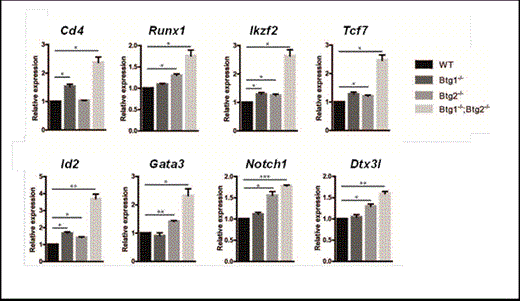Abstract
In B cell neoplasia, many transcription factors known to be involved in B cell differentiation and commitment, like E2A, EBF1 and PAX5, are frequently targeted by focal deletions, mutations or chromosomal aberrations. Recent studies have shown that the human genes BTG1 and BTG2 are commonly affected by gene alterations in different B cell malignancies, but their role in normal B cell development has not been established. BTG1 and BTG2 can act as transcriptional cofactors through recruitment of the protein arginine N-methyltransferase PRMT1, which mediates arginine methylation of transcription factors, like RUNX1, and on histone 4 arginine 3 (H4R3). Here we report that Btg1 and Btg2 display unique and overlapping functions during mouse B cell development. We observed a reduction in the fraction of B220+ progenitor cells in the bone marrow compartment of the different knockout animals, ranging from a 10% decrease in the Btg2-/-, 20% in Btg1-/- , and 40% in the Btg1-/-;Btg2-/- mice relative to wild-type controls. Deficiency for Btg1, but not Btg2, resulted in reduced outgrowth of IL-7 dependent lymphoid progenitors in methylcellulose, which correlated with a higher fraction of apoptotic cells. Btg2-/- mice showed impaired differentiation at the pre-pro-B, pro-B and pre-B cell stage, while Btg1-deficiency mainly affected later stages of B cell differentiation with reduced numbers of immature B cells. Btg1-/-;Btg2-/- mice displayed additive effects with more significant reduction of B220+ cells predominantly at the pre-B and immature B cell stage. Expression analysis revealed no reduction in the mRNA levels of master regulators E2a, Foxo1, Ebf1 and Pax5 in the absence of Btg1 and Btg2. However, higher expression levels of T cell-specific genes were observed in Btg1-/-;Btg2-/- progenitor B cells, e.g. Cd4, Ikzf2 and Tcf7 (Figure 1), some of which are known to be transcriptional repressed by Ebf1, such as Id2, Gata3, Dtx3l and Notch1. Flow cytometric analyses confirmed increased expression of CD3, CD4 and CD8 markers on CD19+ bone marrow cells lacking Btg1 and Btg2 function. Additionally, we detected enhanced levels of DC, NK and myeloid markers on Btg1-/-;Btg2-/- CD19+ BM cells, indicating that Btg1 and Btg2 repress alternative cell fates during B cell lineage specification, and are required for the maintenance of B cell identity. Biochemical studies showed evidence for a physical association between Ebf1, Btg1/Btg2 and PRMT1. We propose a model in which Btg1 and Btg2 affect the function of the critical B cell transcription factor Ebf1 by recruitment of PRMT1.
Aberrant T-lineage expression in progenitor B cells deficient for Btg1 and Btg2. Relative expression levels of Cd4, Runx1, Ikzf2, Tcf7, Id2, Gata3, Notch1 and Dtx3l were determined on cDNA generated from B220+ BM cells of wild-type (WT), Btg1-/-, Btg2-/- and Btg1-/-;Btg2-/- mice by quantitative real-time PCR and normalized to the expression of the housekeeping gene TATA box binding protein (TBP). Data represent the mean and SEM of three independent experiments containing cDNA derived from 2 different biological samples. *, P< 0.05, **, P< 0.01, ***, P< 0.001.
Aberrant T-lineage expression in progenitor B cells deficient for Btg1 and Btg2. Relative expression levels of Cd4, Runx1, Ikzf2, Tcf7, Id2, Gata3, Notch1 and Dtx3l were determined on cDNA generated from B220+ BM cells of wild-type (WT), Btg1-/-, Btg2-/- and Btg1-/-;Btg2-/- mice by quantitative real-time PCR and normalized to the expression of the housekeeping gene TATA box binding protein (TBP). Data represent the mean and SEM of three independent experiments containing cDNA derived from 2 different biological samples. *, P< 0.05, **, P< 0.01, ***, P< 0.001.
No relevant conflicts of interest to declare.
Author notes
Asterisk with author names denotes non-ASH members.


This feature is available to Subscribers Only
Sign In or Create an Account Close Modal